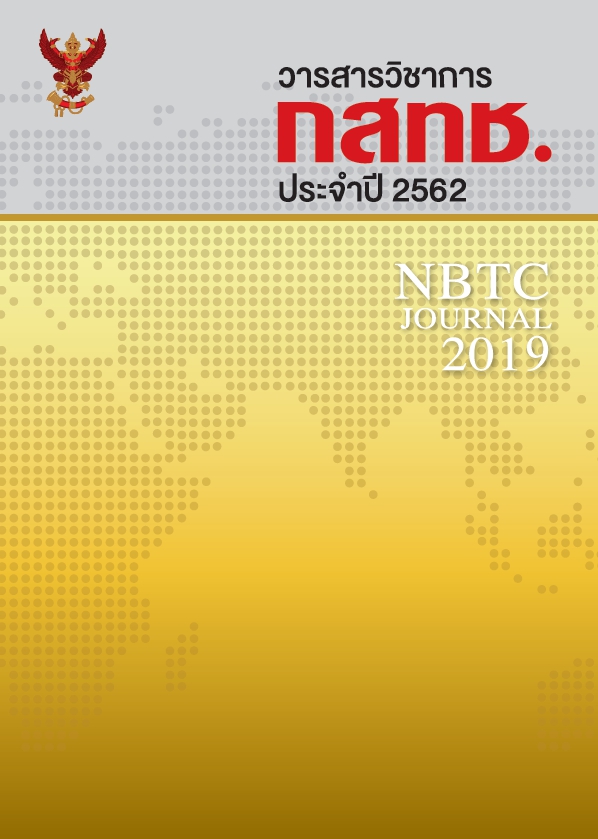Polar Codes : The Error Correcting Codes in 5G Communication Systems
Keywords:
Polar codes, Successive cancellation decoder, AWGN channel, Code rate, Log-Likelihood RatioAbstract
This study presents the details of polar codes which is an experimental research for new type of error correcting codes adopted for the new standard in the 5th Generation of wireless communication systems or 5G. The structure of Polar codes defines by 4 parameters ; is length of codewords; is length of data bits; is a position of frozen bits equal to and is vector that contains binary bit 0 or 1. The encoding of the Polar codes was created by the generator matrix which is the multiply Kronecker product of for times then set a position of forzen bits. Next, the perfomance of Polar codes was estimated on additive white Gaussian noise (AWGN) channel. Decoding the Polar codes was done by changing the signal form AWGN channel to Likelihood Ratio (LR). The bit error rate was also evaluated performances over additive white Gaussian noise (AWGN) channel. The stimulation in which of decoding the structure of Polar codes at 2/3 has bit error performance better that at 1/2 and 1/3, respectively. On the other hand, the sending time for decoding of Polar codes at 2/3 has greater than 1/2 and 2/3, respectively. According to this finding, the performance of bit error rate at 2/3, 1.2 and 2/3 is chronological better. However, the processes for sending the data require more time period.
References
Arikan, E. (2008). A performance comparison of polar codes and Reed-Muller codes. IEEE
Communications Letters, 12(6), 447-449. doi:10.1109/LCOMM.2008.080017
Arikan, E. (2009). Channel Polarization: A Method for Constructing Capacity-Achieving Codes
for Symmetric Binary-Input Memoryless Channels. IEEE Transactions on Information
Theory, 55(7), 3051-3073. doi:10.1109/TIT.2009.2021379
Bioglio, V., Condo, C., & Land, I. (2018). Design of Polar Codes in 5G New Radio. Corenll
University. Retrieved from https://arxiv.org/abs/1804.04389.
Chen, K., Niu, K., & Lin, J. (2013). Improved Successive Cancellation Decoding of Polar Codes.
IEEE Transactions on Communications, 61(8), 3100-3107. doi:10.1109/TCOMM.
070213.120789
Tal, I., & Vardy, A. (2013). How to Construct Polar Codes. IEEE Transactions on Information
Theory, 59(10), 6562-6582. doi:10.1109/TIT.2013.2272694
Vangala, H., Viterbo, E., & Hong, Y. (2014). Permuted successive cancellation decoder for
polar codes. ieeeplore Digital Library. Retrieved from https://ieeexplore.ieee.org
/document/8007003.
Xiong, C., Lin, J., & Yan, Z. (2016). Symbol-Decision Successive Cancellation List Decoder for
Polar Codes. IEEE Transactions on Signal Processing, 64(3), 675-687. doi:10.1109
/TSP.2015.2486750
Zhao, S., Shi, P., & Wang, B. (2011). Designs of Bhattacharyya Parameter in the Construction
of Polar Codes. ieeexplore Digital Library. Retrieved from https://ieeexplore.ieee.org/
abstract/document/6040179.
Downloads
Published
How to Cite
Issue
Section
License
The Office of the NBTC holds the copyright of articles appearing in the journal. The Office of the NBTC allows the public or individuals to distribute, copy, or republish the work under a Creative Commons license (CC), with attribution (BY), No Derivatives (ND) and NonCommercial (NC); unless written permission is received from the Office of the NBTC.
Text, tables, and figures that appear in articles accepted for publication in this journal are personal opinion and responsibility of the author, and not binding on the NBTC and the Office of the NBTC. In case of errors, each author is solely responsible for their own article, and not concerning the NBTC and the NBTC Office in any way.



